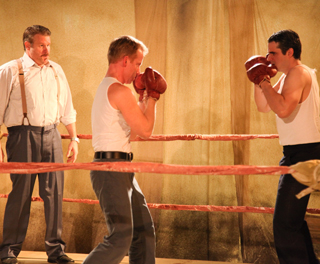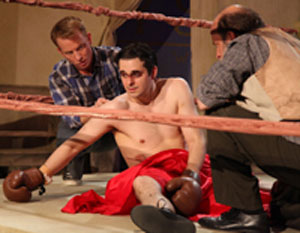
Swordplay and shootouts, karate chops and full-cast tavern brawls, all are capable of dazzling audiences while in progress, but two men facing off, eye-to-eye, in a roped-off arena, is a picture that resonates with spectators long after the activity ceases and the show is finished. Skeptics seeking proof of the indelible impression engendered by pugilistic pageantry should note that in the last twenty years, every Chicago production featuring showdowns in the ring, from Never Come Morning in 1995 to last season's The Opponent, has been rewarded with multiple Joseph Jefferson honors.
Seanachai Theatre Company hopes to continue this tradition with their upcoming production of Billy Roche's Lay Me Down Softly—its setting, Ireland during the early 1960s, and its populace, the players in a traveling carnival anchored by boxing matches recalling the ghosts of past fights and portents of those to come.
What is it about the "sweet science"—as A. J. Liebling dubbed the sport—that so appeals to playwrights and playgoers alike?
"Boxing is a formalized version of a primal instinct," says Lay Me Down's director Kevin Fox, "What theater offers is a window into the before/after of the event and into the humanity of the fighters."
Jonathan Berry, director of Griffin Theater's recently-closed Golden Boy, concurs, "Boxing feeds into the mythology of the American Dream—whoever you are outside the ring, wherever you came from or whatever your past, once the bell rings, you have the opportunity to make your fortune."
The assemblers of these carefully-choreographed fisticuffs also have their theories. Seanachai's fight designer John Tovar (whose 90-minute sparring session for Kamal Angelo Bolden and Guy Van Swearingen in The Opponent earned him a Jeff in 2013) observes, "Today's audiences have an emotional connection with boxing that they don't with, say, a sword fight, since swords aren't a part of our everyday lives any more."
Nick Sandys, recipient of a 2008 Jeff for his curtain-raising solo round in Requiem for a Heavyweight, points out that boxing was once thought to be healthful exercise for young men of all social classes and taught in the schools as such. Tovar acknowledges boxing's sporting nature, but still claims the audience response to be more closely associated with witnessing a spontaneous bare-knuckles fist fight. "Most people, at some point in their lives have imagined themselves hitting someone—even if they've never done it."
 The ritual of boxing also contributes to the dramatic tension, maintains Fox, "The natural flow of boxing is full of breaks, approaches and retreats. It becomes a series of short, intense, sequences that make the story of the bout easy to follow. The presence of the referee adds to the mystique—I can't think of any other sport where the umpire makes physical contact with the participants in the course of the action."
The ritual of boxing also contributes to the dramatic tension, maintains Fox, "The natural flow of boxing is full of breaks, approaches and retreats. It becomes a series of short, intense, sequences that make the story of the bout easy to follow. The presence of the referee adds to the mystique—I can't think of any other sport where the umpire makes physical contact with the participants in the course of the action."
So is it boxing's slower pace—when compared to a duel with rapiers, for example—that renders it exciting? Or is that only the theatrical version?
"There are fighters who are incredibly fast—look at Oscar de la Hoya or Manny Pacquaio—but being able to see the faces certainly helps," Tovar reminds us, while Sandys adds, "In a real match, eighty percent of the punches never land anywhere, but a play doesn't permit us to go a full ten rounds, so stage boxing is no less artistically shaped than any other theatrical violence."
"It's so American," insists Berry, "You set a goal and then strive to achieve it."
Lay Me Down Softly runs through May 25 at the Den.
Mary Shen Barnidge
Contributing Writer

 Follow Us On Twitter
Follow Us On Twitter